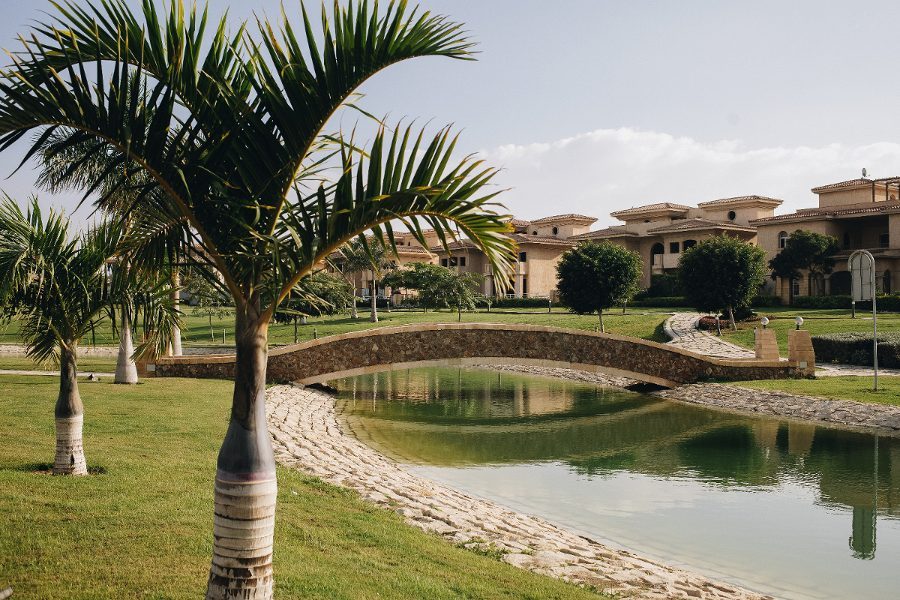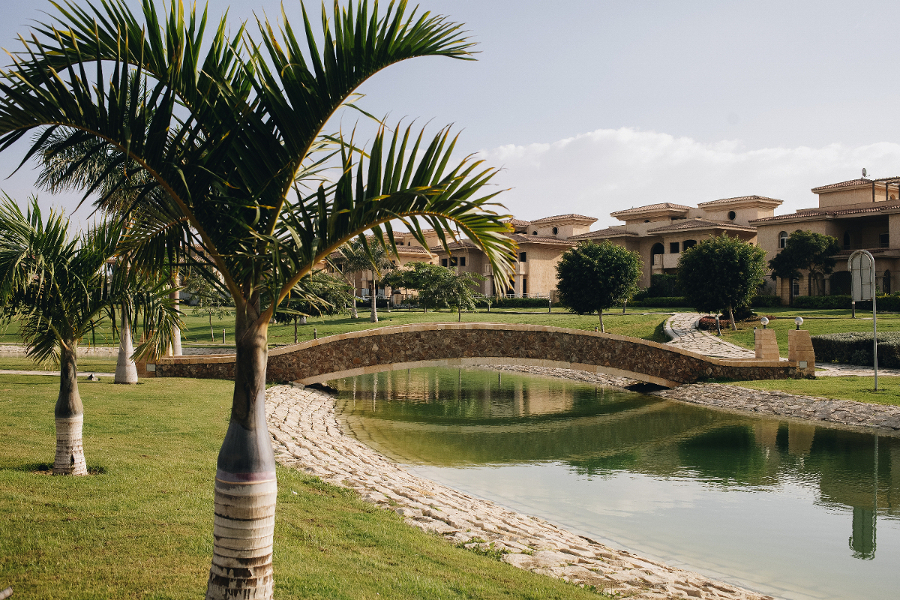At the gate, a security guard taps my friend’s car with two fingers. When we roll down the window, he offers no greeting. His eyes meet our own expectantly, asking the questions his lips do not bother to formulate: Where are you going? Who are you looking for? What business do you have coming here?
Following our response, the wooden bar guarding the entrance lifts and we are inside Beverly Hills — not the coveted set of Hollywood classics, but one of the oldest residential complexes in Sheikh Zayed city, off the Cairo-Alexandria Desert Road.
Like its American namesake, the residential community is home to palm-lined streets and elegant buildings. What the shared title also points to is a mutual aspiration of the two suburbs: to serve as a peaceful haven, far from the chaos of an overcrowded metropolis.
Within these walls, life does seem to unfold at a different pace. Despite the warm weather, pedestrians are few and far between. A group of girls ride by on electric scooters and bicycles. They are dressed seasonally, in shorts and sundresses, unbothered by catcalls and other threats they would likely face had they been in the city center, some 40 kilometers away, to the east.
They look young enough to have lived here most, if not all, of their lives. Watching them, I find myself wondering: what does it mean to grow up and live in a gated community? Beyond questions of material wealth, is there a cultural gap between those living in compounds and the rest of the city?
Compounds in Egypt have long been the object of widespread social debate, particularly in the years since the 2011 revolution, when concerns over safety led many families to trade their in-town apartments for suburban homes.
While some accuse them of strengthening already deep divisions between rich and poor, others view compounds as a good means to solve overcrowding in the capital, or as replicable models of communal living. The debate is of heightened relevance today, as the first generations of people born and raised in these gated communities transition to adulthood.
Class delinations take physical form
Suburbia has occupied a central place in the Western cultural imagination since the 1950s, when the post-war middle class ideal increasingly shifted towards white-picket-fenced houses large enough to accommodate growing families.
American suburbs and their cultural implications have since been the subject of extensive art production and sociological research, largely pointing to the existence of a uniquely suburban culture, characterized in part by class and racial segregation.
In Egypt, the phenomenon is more recent but prone to the same accusations of elitism, and perhaps to an even greater extent.
Cairo’s suburbs as we know them today — clusters of gated residential communities on the city’s outskirts — largely took shape in the mid-1990s, when large plots of public land were sold to private real estate developers to help alleviate population density in the capital.
Private developers, however, cannot solely be motivated by the noble aim of providing better housing opportunities to citizens. To generate profit, they were faced with the challenge of providing sufficient incentive for Cairenes to pay ample money to move dozens of kilometers away from their hometown and places of work.
The answer to this marketing challenge laid in a promise of luxurious living and safety from the ills of an unruly urban landscape. As such, the key criticism aimed at residential compounds in Egypt is also their primary selling point: that they protect their inhabitants from the outside world with physical gates barring access to non-residents.
In 2020, a television advertisement for Madinaty — a gated residential complex on the furthest eastern outskirts of Cairo — aired during the month of Ramadan, to widespread social media controversy. In the advertisement, residents were shown listing the services available to them within Madinaty, praising the fact that they seldom needed to venture beyond its gates.
Critics of the advertisement denounced it as an insensitive flaunting of wealth in a country where most people are poor, and were made more so by the economic ravages of the COVID-19 pandemic. An additional source of controversy was the emphasis on its exceptional ‘community,’ used here to denote the exclusive nature of this residential complex.
As several writers have noted, the gated nature of residential compounds is not only a guarantee of security, but of social seclusion from the country’s poor who, then, are perceived as threatening on the sole basis of their economic disempowerment.
Yet, is it fair to say that class segregation arises only where gates are built to wall off rich from poor?
Areas like Zamalek — an upscale residential island in central Cairo, where costs of everything from real-estate to groceries are subject to an unwritten luxury tax — can easily be held up as proof that elitism is not the sole ground of gated communities.
And indeed, there is no overlooking the class symbols that permeate its every corner: embassies muralled by concrete barricades; plaques ornamenting the entrances of heritage buildings; or the imposing gates of the Gezira Sporting Club, where memberships were once restricted to our British occupiers and those few Egyptians they deemed worthy of admission.
Nonetheless, the fact is that there are no physical barriers of entrance to Zamalek. On its streets, one is just as likely to encounter public school students; professionals traveling to and from their offices; and visitors to its many public gardens, as they are to meet residents of the island.
Anywhere in Cairo, including in its most luxurious neighborhoods, one would have to make a concerted effort to never meet anyone unlike themselves. Compounds, by design, unite residents of a shared socioeconomic status, whose interactions with other strands of society inside the gates unfold almost exclusively in transactional contexts.
Low-income Egyptians are unlikely to access these spaces outside of providing their residents with services: whether as domestic workers, maintenance and security staff, or service workers employed at commercial facilities. This core feature of gated communities, therefore, makes them more prone to a culture of elitism and social seclusion.
Thriving communal spaces or imports of Western individualism?
Madinaty’s emphasis on community is another prime selling point of compounds at large. While they may restrict access and residency to people of a shared socio-economic class, gated residential complexes can still be looked to as one model of orderly, communal living.
Within compounds, residents share the financial burdens of maintaining infrastructure, leisure spaces, and beautification projects. There are also usually mechanisms in place for collective decision-making on matters related to internal policy — mechanisms which are legally implementable and yet largely absent from most of the capital’s neighborhoods.
Through their collective efforts, these residents ensure the continuous availability of amenities, functioning infrastructure, and upkeep of green spaces in a world largely free of violence, theft, sexual harassment and other forms of criminality plaguing the city.
Yet, the question stands: should any of these things be luxuries reserved for citizens of certain means?
One journalist writing for Ahram Online points to the oxymoron contained in the term “gated community,” noting that “community implies the idea of interaction and connection among people to achieve individual and collective goals […].”
By virtue of the gates that surround them, he argues, compounds not only protect residents from the perceived threats of the outside world, but also from having to pay mind to those who live unable to escape the very same problems they fled by moving to the suburbs.
The night following my trip to Beverly Hills, I spent the evening in Downtown Cairo. Walking home, I realized just how much of the world I had seen in those few hours: used book salesmen lining the sidewalks of Talaat Harb, foreigners crowding into Café Riche, bright-wigged mannequins calling into lingerie stores, bridal cars honking celebratorily, lovebirds flocking into cinemas.
Representatives of nearly every strand of Egyptian society come together daily on those streets, hence why it has historically lain at the core of political and cultural organizing in the city.
There is also no turning a blind eye to poverty in Downtown Cairo. Beggars have multiplied in numbers amid a worsening economic crisis; ‘for sale’ signs hang over abandoned storefronts; art galleries turned into commercial warehouses; and a growing number of residential buildings, no longer affordable to their tenants, redesigned into office spaces.
Conversely, I also realized just how little I had seen on my suburban escapade. Our only venture outside of my friend’s home was a thirty-minute walk to and from the supermarket, on which we encountered no other pedestrians. Save for the commercial areas bordering the compound gates, we could have walked on for hours and barely met another soul.
And maybe that’s the whole point.
Through their lush billboards and foreign names imported from equally opulent havens in the Western world, compounds sell the promise of first-world living in a third-world country: space, privacy, and most importantly, distance from a possibly threatening Other.
While these are all evident perks, as the above writer notes, Egyptians, a civilization historically concentrated along the banks of the Nile River, are not accustomed to living walled off from one another. Physical proximity may not be the sole driver of community, cultural exchange, or resistance, but it does help bolster a sense of mutual responsibility towards one another.
As private schools, universities, and corporate headquarters migrate to the outskirts of the capital, there is increasingly less incentive for compound residents to venture to the city center or physically cross over class barriers.
Those born and raised within gated communities, unlike previous generations who migrated to the suburbs, are likely to grow up depoliticized and alienated from the country’s broader culture – the good, the bad, and the plight of millions living under the poverty line.
I do not believe there is anything wrong or morally reprehensible with choosing better housing and living opportunities when one can afford it. I also do not believe that the onus for solving structural inequality should fall on the shoulders of individual citizens.
Nonetheless, it is easier to look away from suffering when one simply does not see it. Western names, Western spaces, and a Western ethos of comfort can also translate to the flipside of Western cultures: individualism – an epidemic which grows more rampant as gates rise to segregate different strands of a deeply unequal society.
The opinions and ideas expressed in this article are the author’s and do not necessarily reflect the views of Egyptian Streets’ editorial team. To submit an opinion article, please email [email protected].







Comments (0)